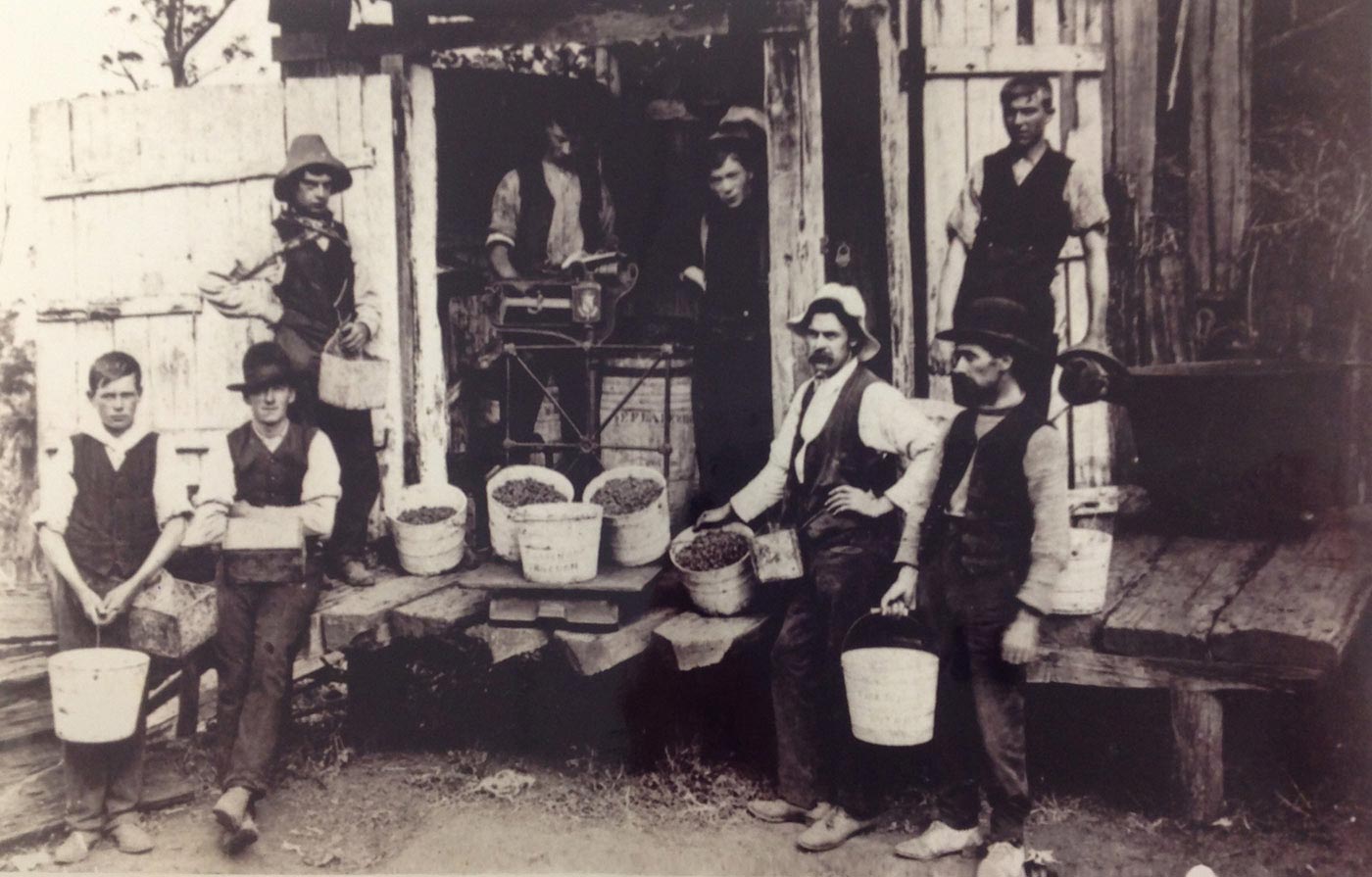Monbulk is a town established in the 1890s in the Dandenong Ranges, east of Melbourne, in the traditional territory of the Wurundjeri people.
In the second half of the 19th century, farmers discovered fertile volcanic soils beneath the wet forests of the Dandenongs. Writer and literary critic Nettie Palmer lived in the Dandenong Ranges in the first decades of the 20th century. The region, she noted, swiftly became renowned for berry farming:
In the seventies there were cleared pockets of land, facing the east and screened by tall timber, where strawberry plants but still more raspberry canes were flourishing and bearing as never on the plains. The district seemed to live for those seven summer weeks in the year, when, on the longest of days, picking went on from magpie to mopoke. The soil was new and rich. There were no pests; and the shade was right. After all, in European countries the berries grow inside forests, so these mountain glades were at their best for the fruit when their timber still grew tall and copious.
Robert Orlando Cowey and his photographs

Robert Orlando Cowey arrived in the Monbulk district in the early 1890s when he was about six years old.
On ‘Weardale’, their small farm, his parents John and Augusta build a hut with fern log walls, a roof of mountain ash palings, and an earthen floor covered with the soft fronds of tiny ferns.
They established an orchard, planted berries, potatoes and other vegetables, milked cows, and sold excess butter to neighbours.
Robert spent some time at Monbulk Primary School, which opened in 1897. After serving at Gallipoli and in France during the First World War, Robert returned to the Monbulk district to manage Weardale.
Before enlisting as a soldier, Robert Cowey was a keen photographer. His descendants recently donated to the Museum a collection of photographs taken by Robert, and his camera.
Monbulk jam

Between 1913 and 1991 most Australian kitchen cupboards held a jar of Monbulk jam.
Daniel Camm was a pioneer of berry farming in the Dandenong Ranges. With help from his sons, Camm grew flourishing crops of raspberries, loganberries, gooseberries, strawberries, and red and black currants.
Like other fruit growers, Camm struggled to make a profit when sales required slow haulage of the fragile harvest over rough mountain tracks.
To overcome this problem, he decided to establish a pulping and tinning plant, later transformed into a jam factory. He bought berries and other fruits from local growers, and sold the jam under the brand names ‘Quail’ and ‘Monbulk’.
During the Second World War, the company secured contracts to supply jam to the armed forces of Britain and Australia. Post war food shortages in Europe bolstered exports and company profits. By 1970, the Monbulk factory produced more than 5 million kilograms of jam each year.
In the early 1970s the Camm family sold their company to an English firm, which later transferred the Monbulk factory to the Shepparton Fruit Preserving Company (SPC). SPC closed the Monbulk factory in 1991.
Monbulk jam labels produced from the 1920s to 1940s
Lyrebirds and muskets
The wet forests of the Dandenong Ranges held rich food resources for Wurundjeri people. Plants offered fruits and tubers. Like other Aboriginal groups in Australian rainforest regions, Wurundjeri extracted and ate the pithy core of tree ferns.
Throughout the Dandenongs, they hunted kangaroos, possums, lizards, koalas, bandicoots, wombats and birds.
In the 1840s George Augustus Robinson wrote of 40 Aboriginal men spending two weeks hunting lyrebirds in the Ranges. Wurundjeri people sold the bird’s magnificent tail feathers to Melbourne exporters, sometimes acquiring guns in exchange.
In 1840 a farmer at Yarra Glen, just north of the Dandenongs, accused a group of armed Wurundjeri of plundering his potato crop. Wurundjeri men tried to shoot the farmer with their muskets. Three years of conflict between farmers and Wurundjeri followed, only to end with the hanging of three Wurundjeri fighters in Melbourne.
Monbulk Primary School
Monbulk Primary School is a small school in the Dandenong Ranges, east of Melbourne. When the school joined the Stephanie Alexander Kitchen Garden Foundation program in 2011, parents and other community members pitched in to transform the old library building into the new kitchen, and to establish the kitchen garden.
References
Betty Hotchin and Jill A’Vard, Monbulk Jam at The Patch, Monbulk Historical Society, Monbulk, 2013.
Monbulk Historical Society, Patch Pioneers, vol. 2, Monbulk, 2004.
Mount Evelyn History Group, Aborigines in the Yarra Valley and Northern Dandenongs, Yarra Ranges Council, 2011.
Nettie Palmer, ‘The meaning of the Dandenongs’, Argus, 2 June 1934, p. 9.
‘The Black Protectors’, Sydney Herald, 10 February 1840, p. 2.
‘Wilderness blossomed for wharf worker’, Argus, 7 October 1953, p. 8.
Dorothy Williams, A Century of Monbulk Jam, Monbulk Historical Society, Monbulk, 1989.






















